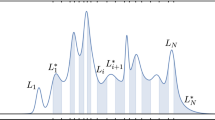Abstract
By combining the upper and lower bounds to the free energy as given by the Gibbs inequality for two systems with the same intermolecular interactions but with external fields differing from each other only in a finite region of space Γ, we show that the corresponding equilibrium densities must also differ from each other somewhere in Γ. We note that the basic equations of density functional theory arise naturally from a simple rearrangement and reinterpretation of the terms in the upper bound Gibbs inequality for such systems and briefly discuss some of the complications that occur when the intermolecular interactions of the two systems also differ.
Similar content being viewed by others
REFERENCES
J. W. Gibbs, Elementary Principles in Statistical Mechanics (Dover, New York, 1960). See in particular, Theorem III, p. 131.
R. Evans, Adv. Phys. 28:143–200 (1979).
R. Evans, in Fundamentals of Inhomogeneous Fluids, D. Henderson, ed. (Dekker, New York, 1992), pp. 85–175
J. P. Hansen and I. R. McDonald, Theory of Simple Liquids (Academic Press, London, 1986).
J. S. Rowlinson and B. Widom, Molecular Theory of Capillarity (Clarendon Press, Oxford, 1989).
N. D. Mermin, Phys. Rev. A 137:1441–1443 (1965).
N. Argaman and G. Makov, Amer. J. Phys. 68:69–79 (2000).
J. Rasaiah and G. Stell, Mol. Phys. 18:249–260 (1970).
J. D. Weeks, D. Chandler, and H. C. Andersen, J. Chem. Phys. 54:5237–5247 (1971).
A. Isihara, J. Phys. A 1:539–548 (1968).
M. Levy, Proc. Natl. Acad. Sci. USA 76:6062–6065 (1979) gave a constructive proof for a T=0 quantum system based on a search for constrained minima similar in spirit to those described here.
J. T. Chayes, L. Chayes, and E. H. Lieb, Comm. Math. Phys. 93:57–121 (1984).
A. Gonzalez, et al., J. Chem. Phys. 109:3637–3650 (1998).
J. D. Weeks, Annu. Rev. Phys. Chem. 53:533–562 (2002).
J. D. Weeks, D. Chandler, and H. C. Andersen, J. Chem. Phys. 55:5422–5423 (1971).
K. Katsov and J. D. Weeks, J. Phys. Chem. B 105:6738–6744 (2001).
Author information
Authors and Affiliations
Rights and permissions
About this article
Cite this article
Weeks, J.D. External Fields, Density Functionals, and the Gibbs Inequality. Journal of Statistical Physics 110, 1209–1218 (2003). https://doi.org/10.1023/A:1022157229397
Issue Date:
DOI: https://doi.org/10.1023/A:1022157229397




